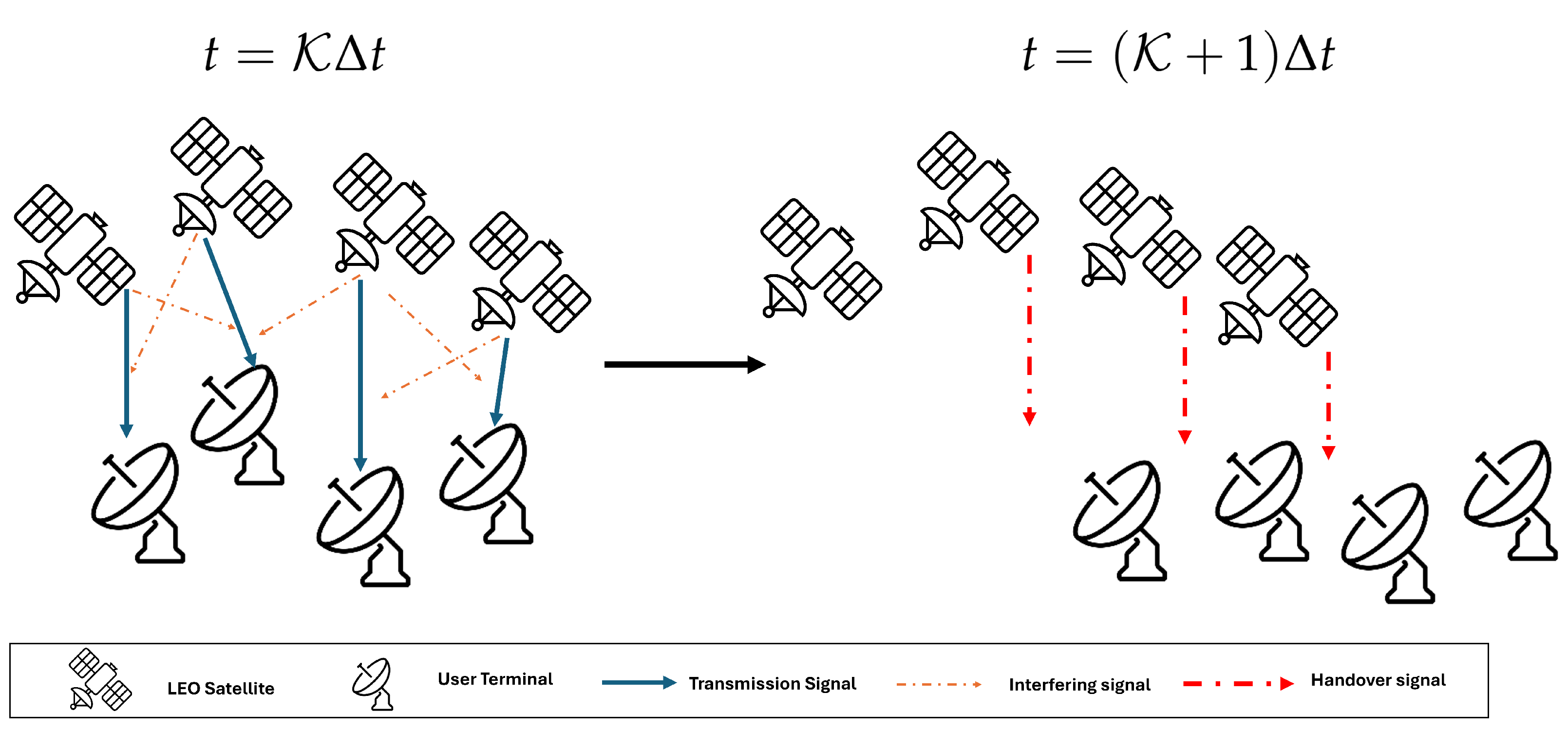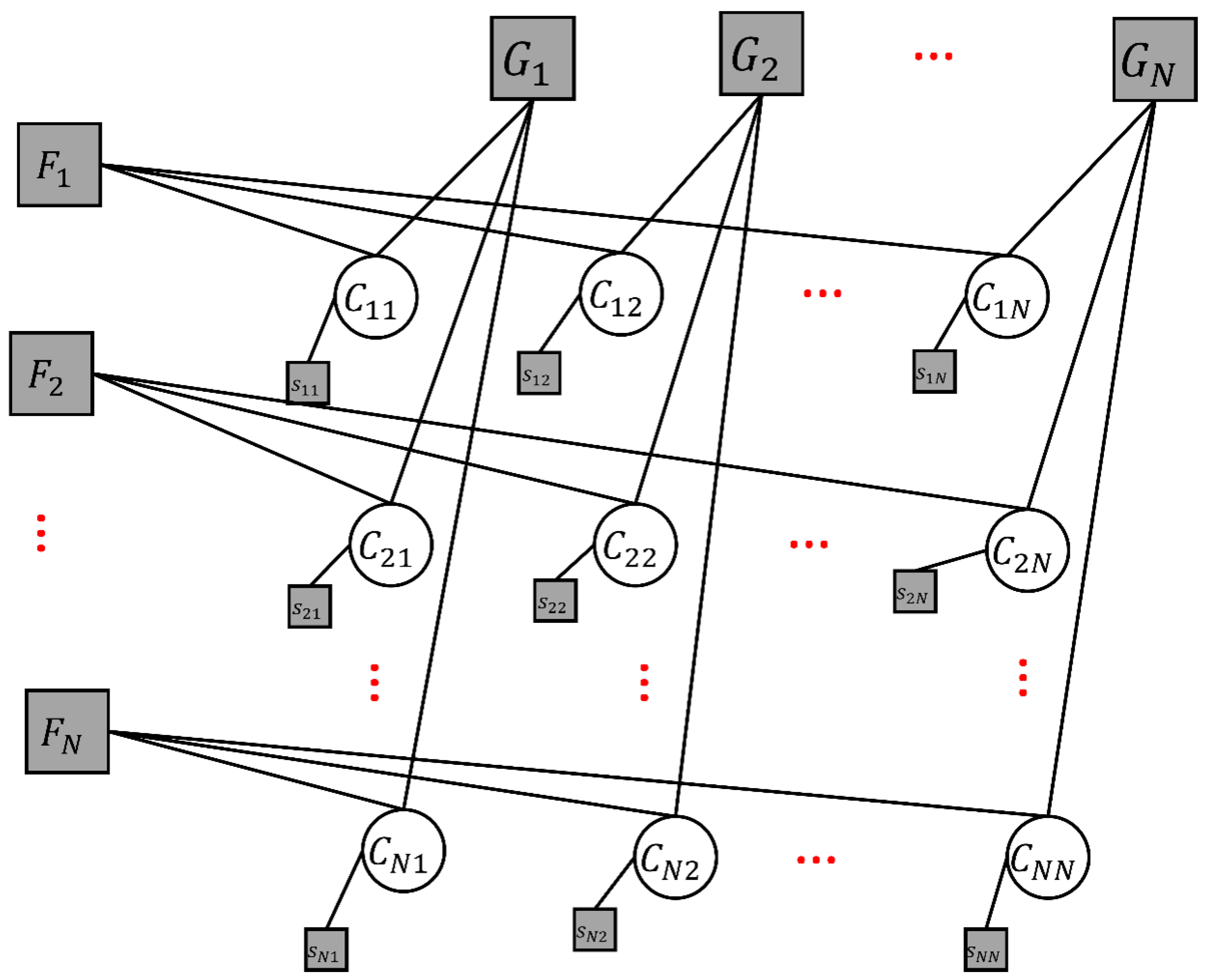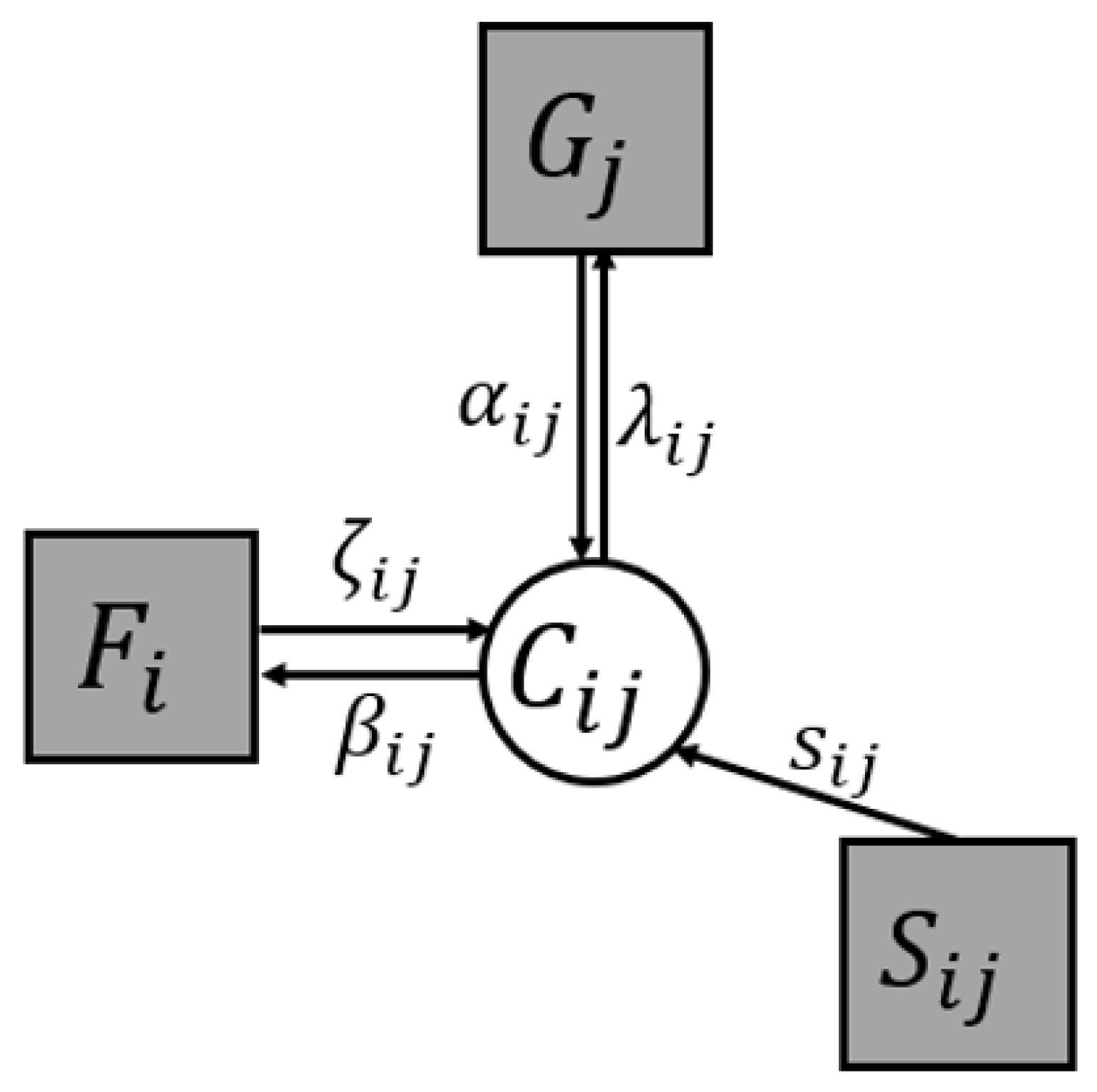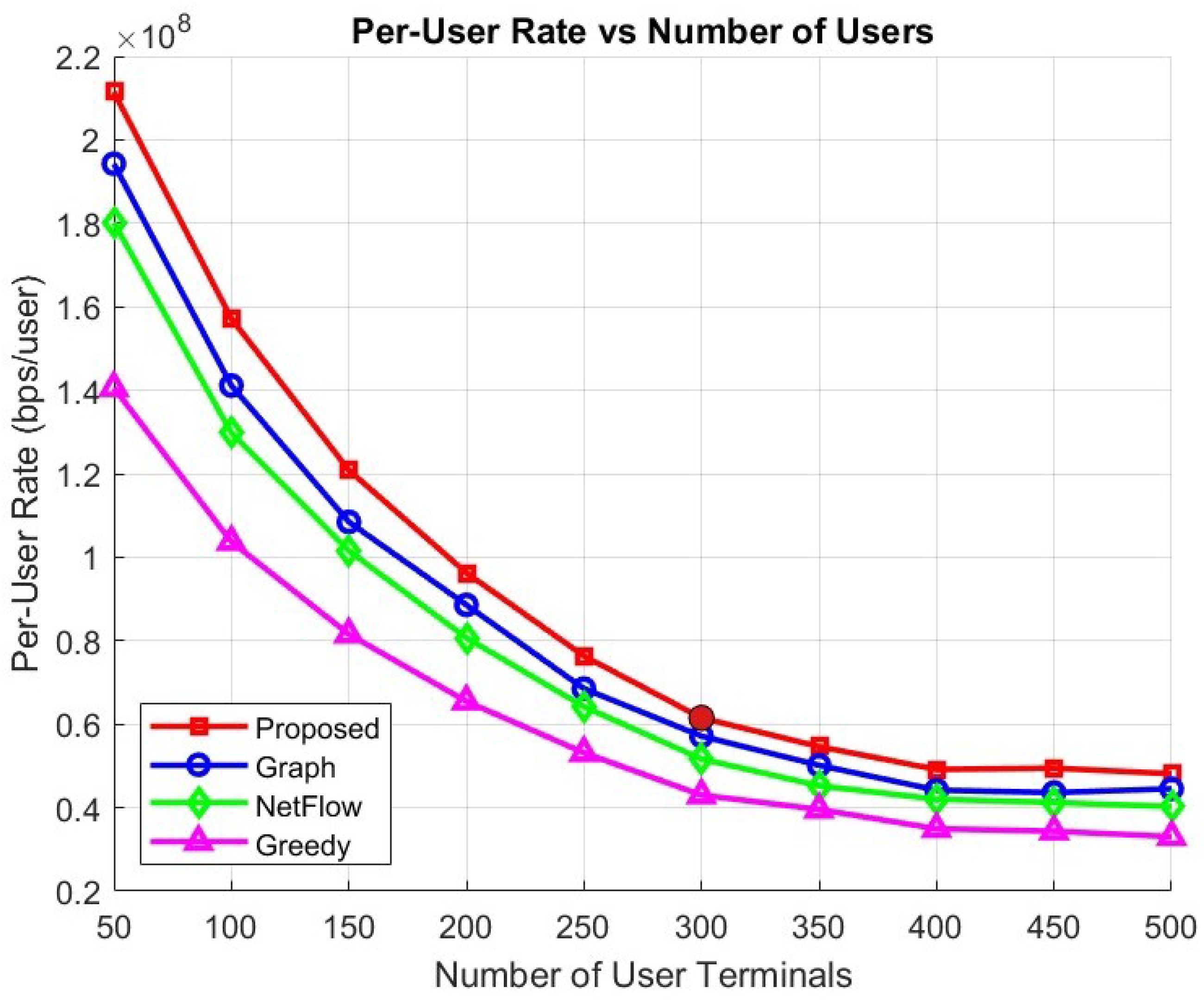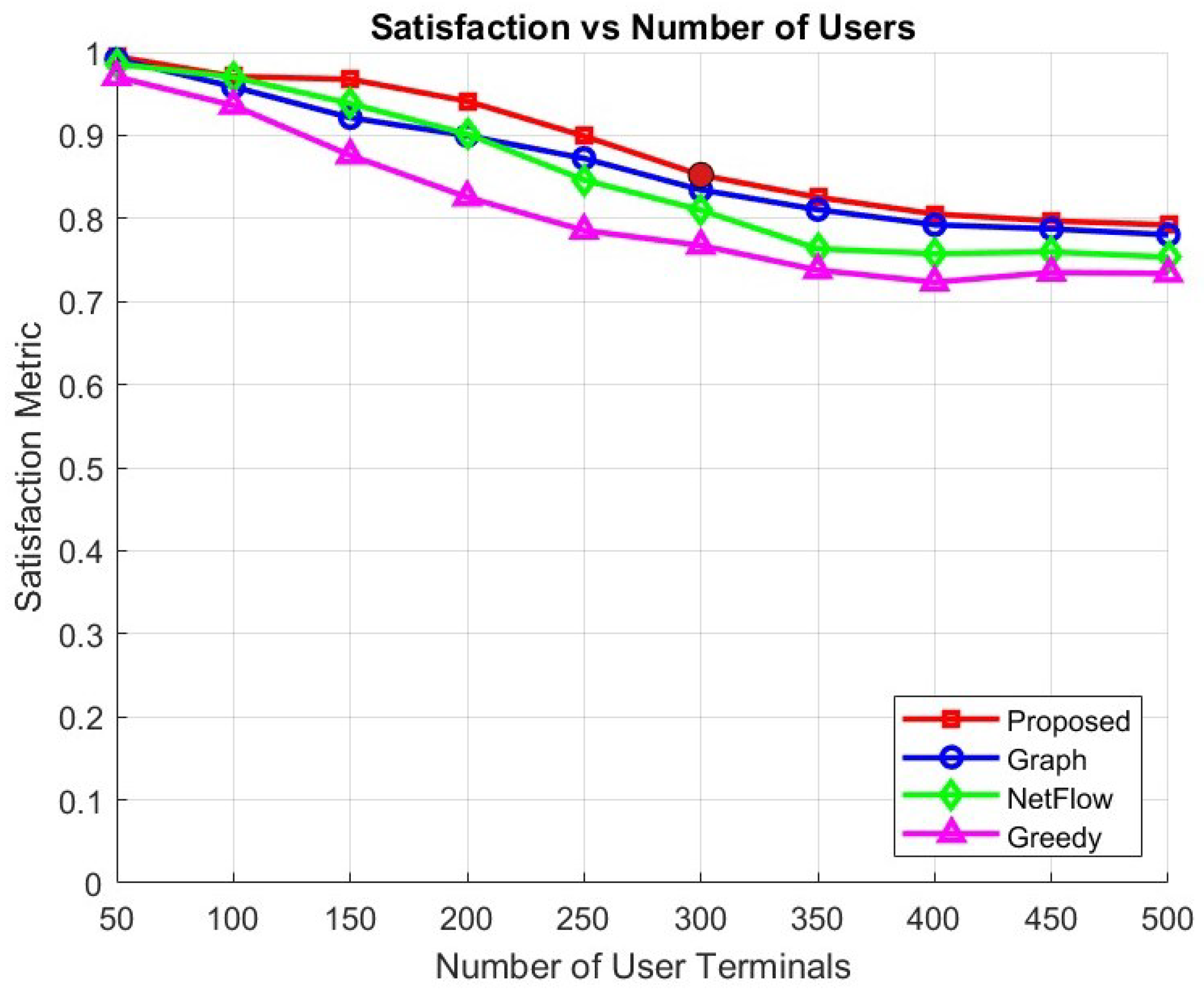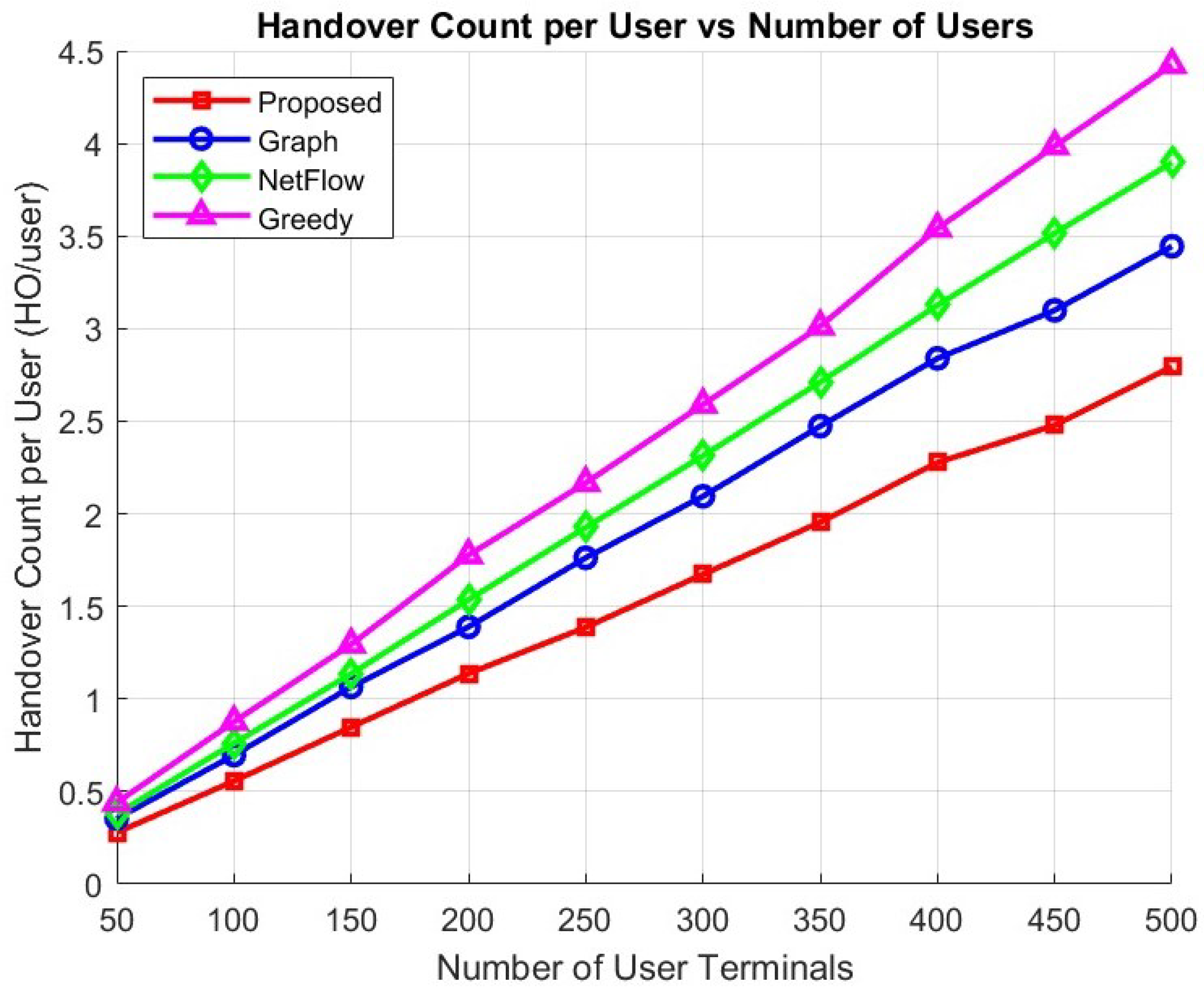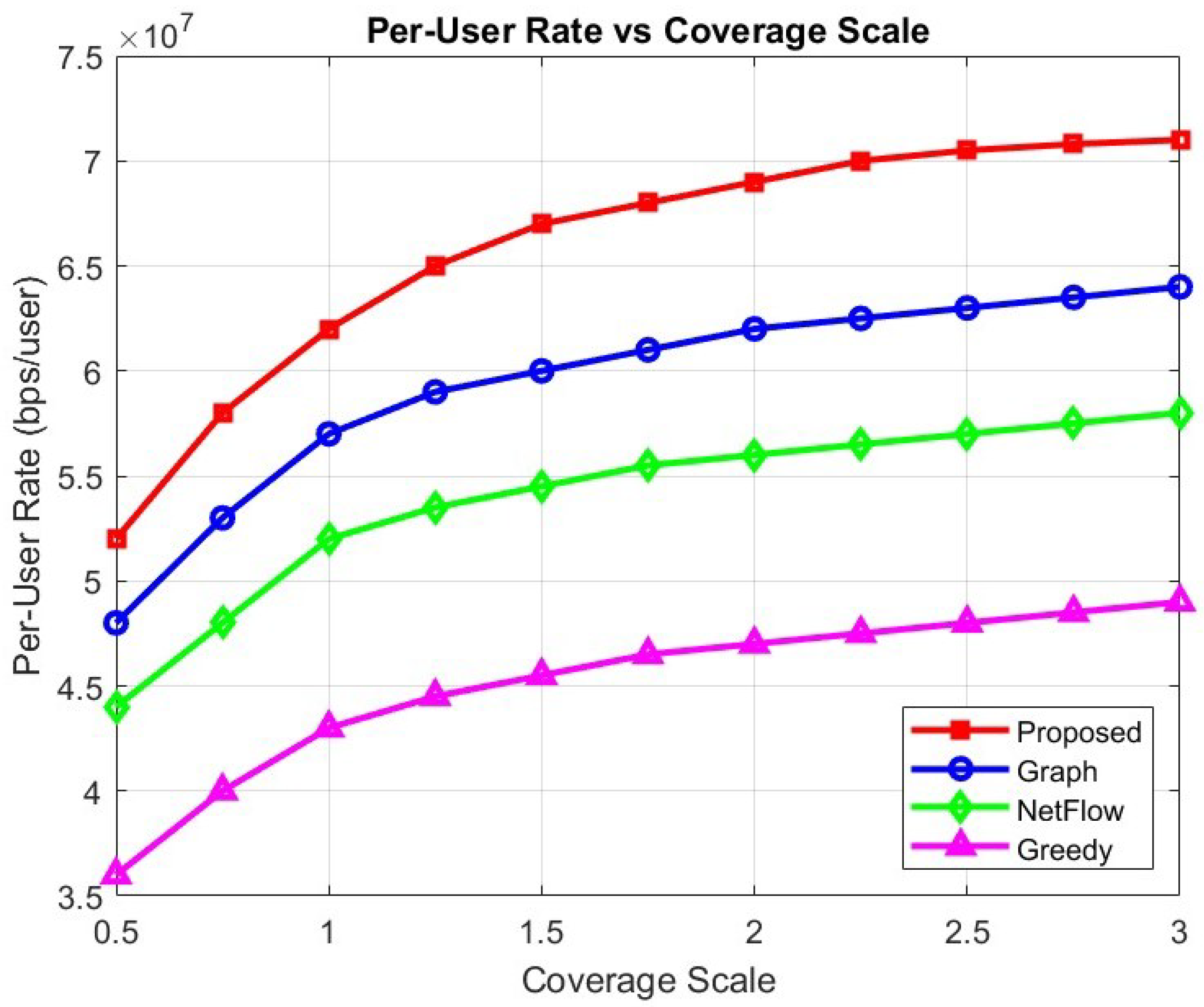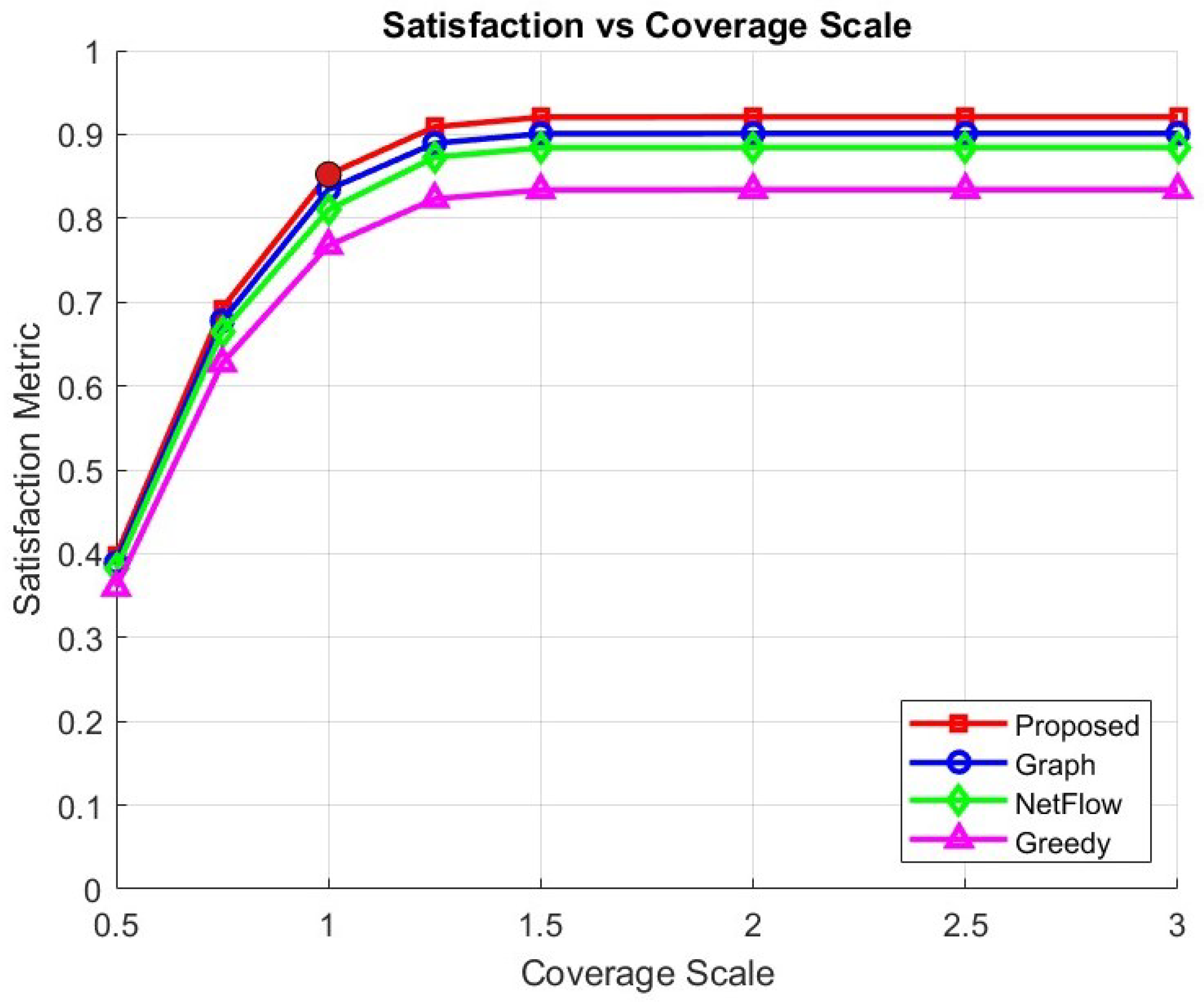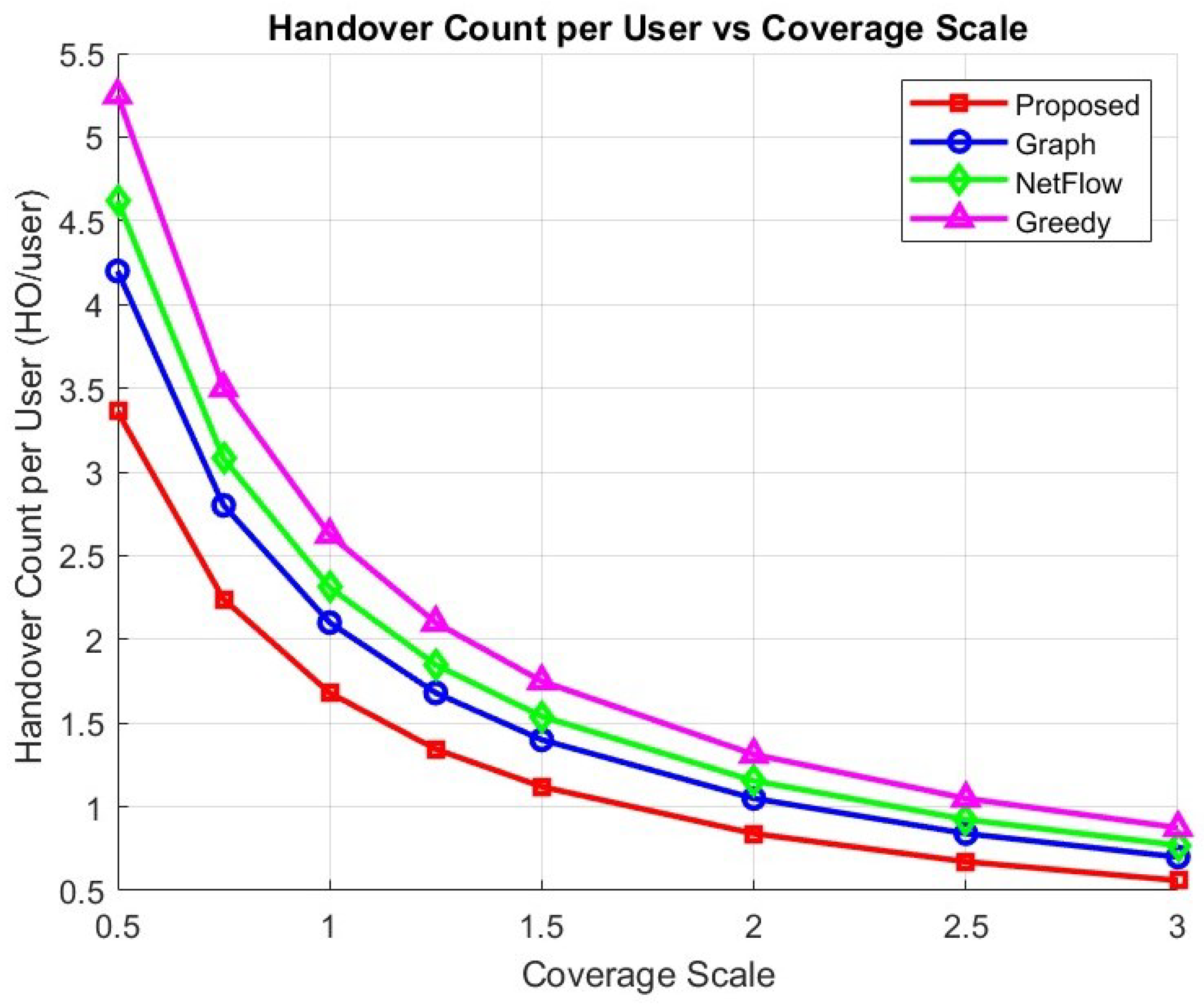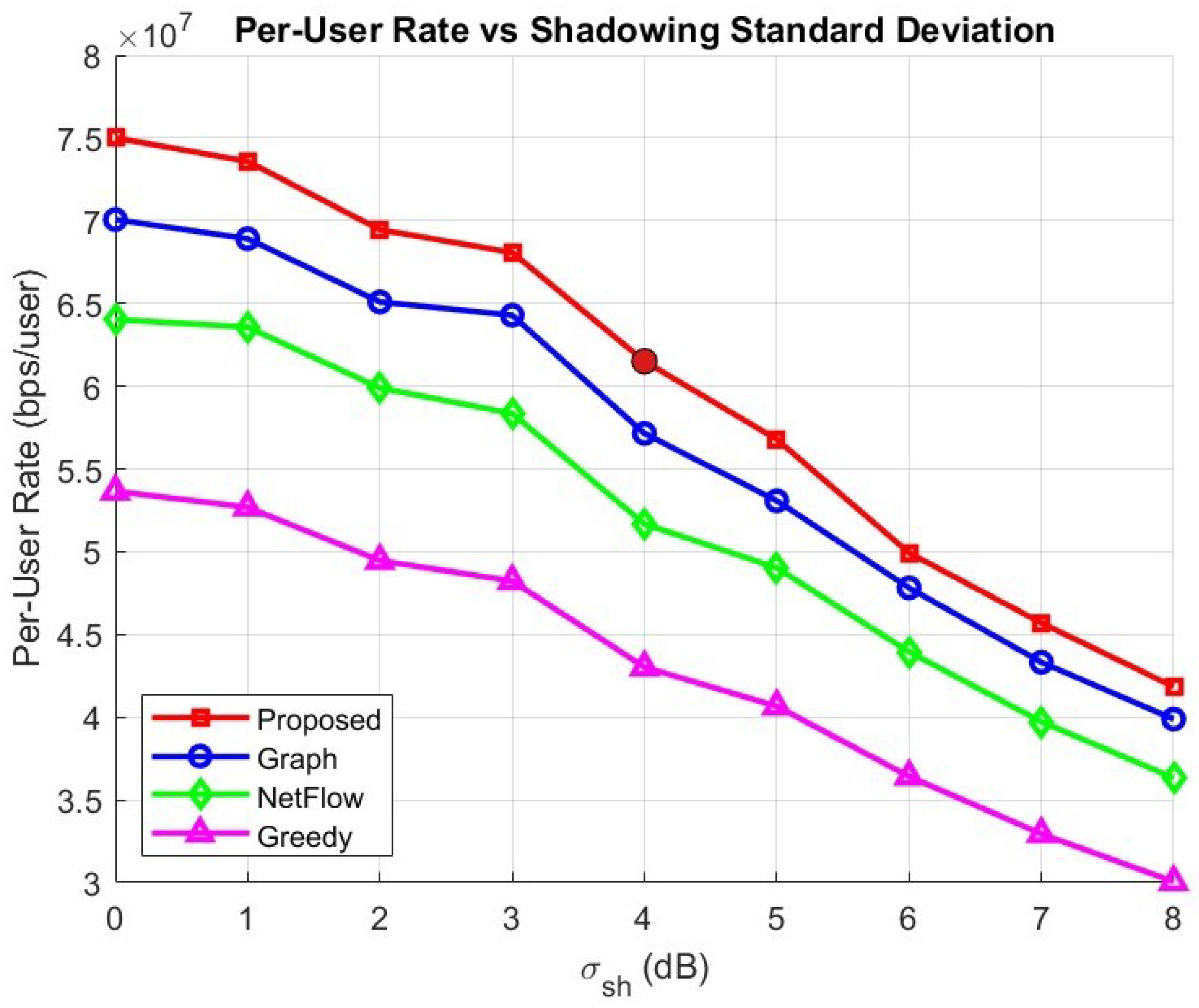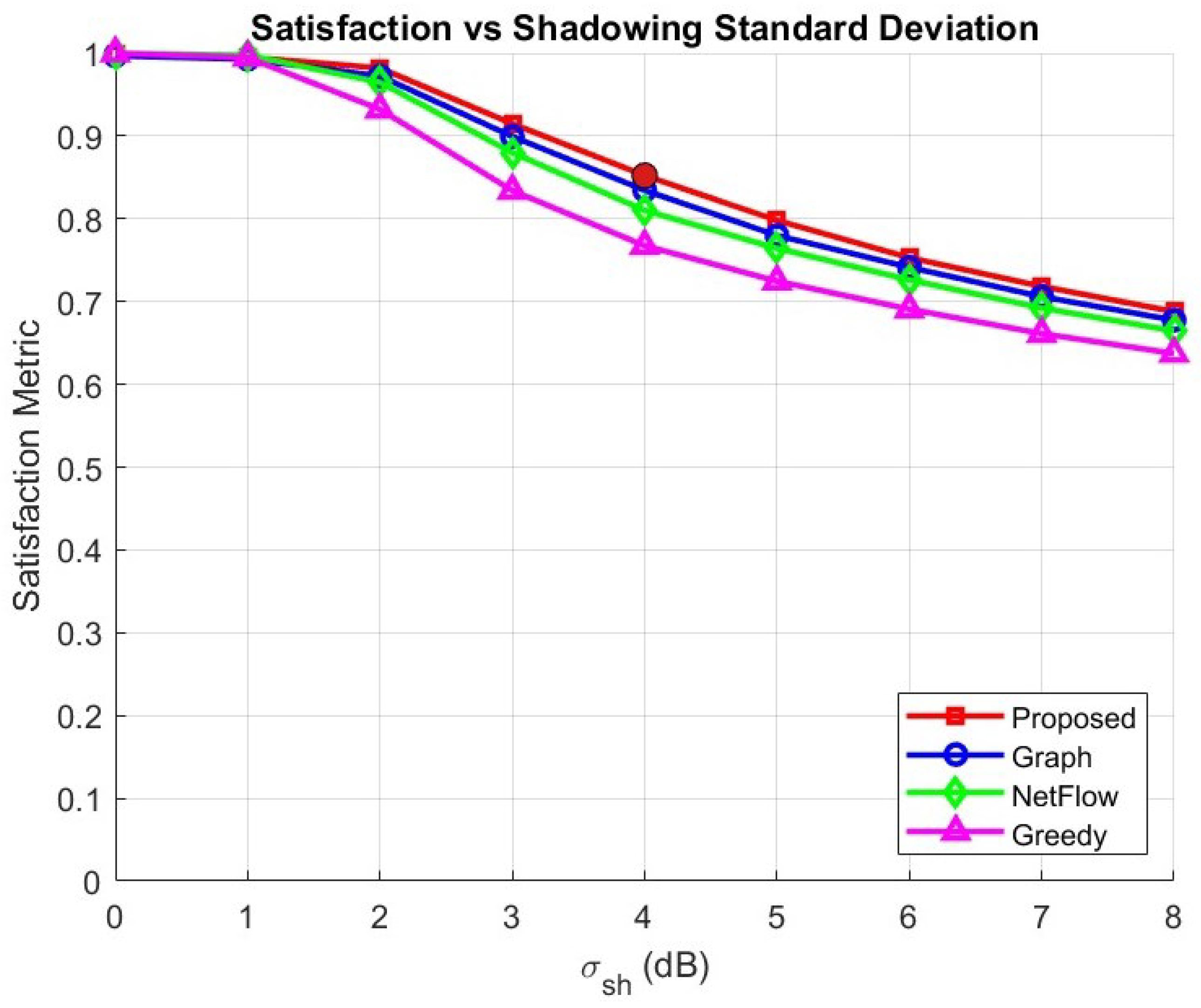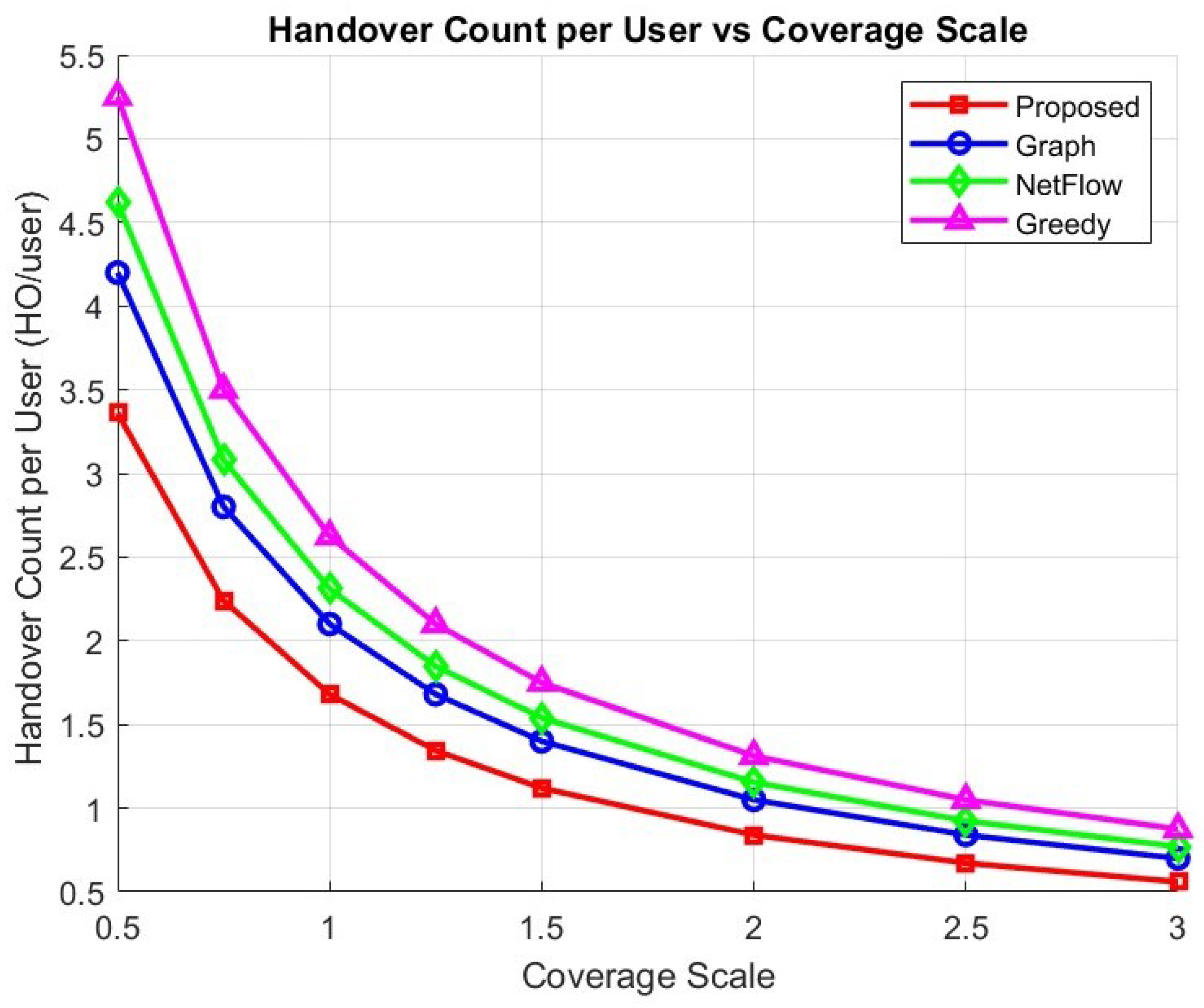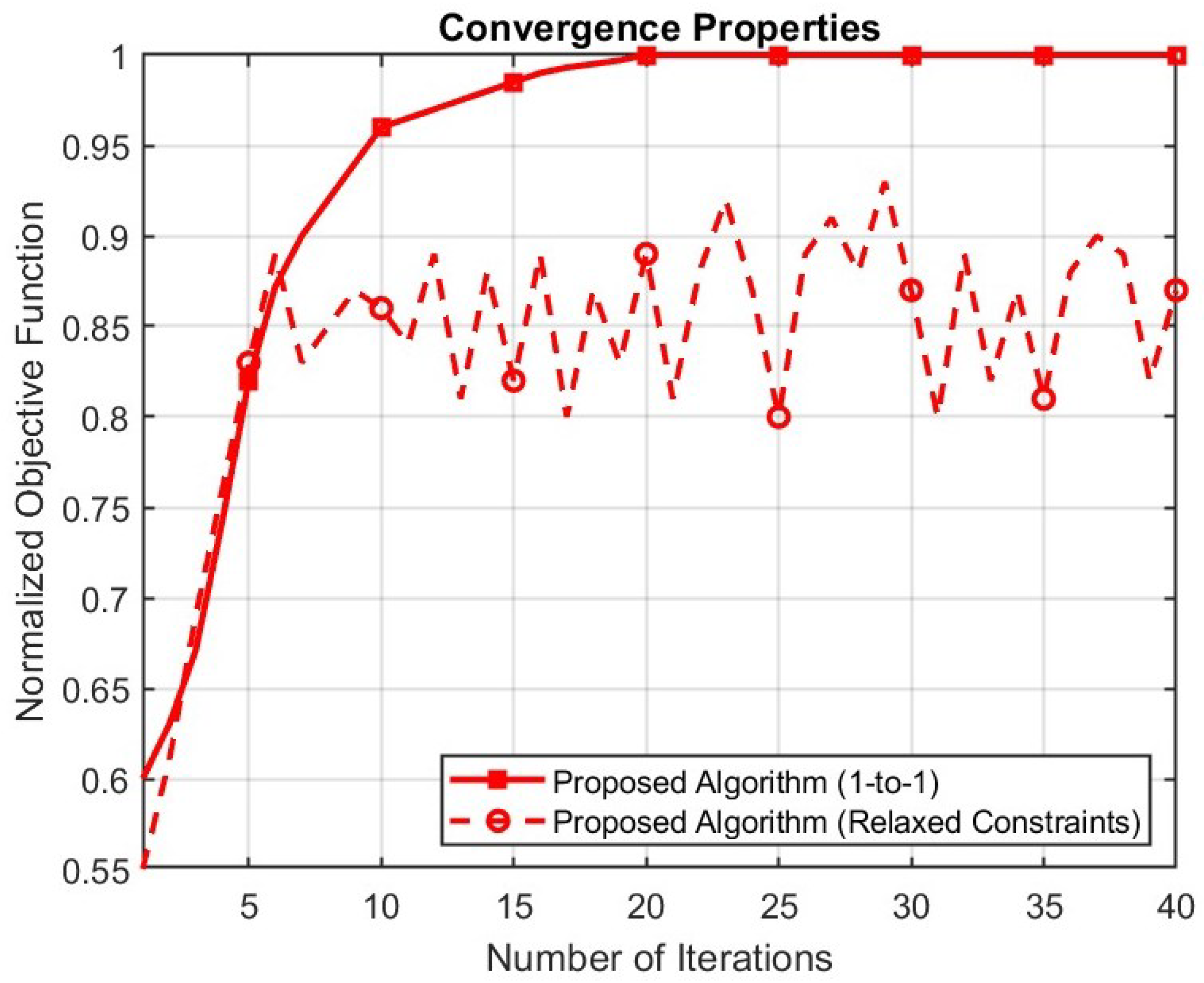1. Introduction
The massive increase in data, evolving from numeric formats to include images, videos, and high-dimensional sensor data, has resulted in a significant burden on traditional communication networks [
1,
2]. Global network traffic is predicted to reach 6641 exabytes per month by 2033, with video accounting for over 45% of this traffic [
3]. This explosive growth in data size and demand significantly degrades the performance of terrestrial networks, which are limited by bandwidth, vulnerable to co-channel interference, and require high latency, especially in rural areas [
4,
5,
6]. Consequently, relying only on terrestrial networks is insufficient to satisfy current and future communication demands. Therefore, Low Earth Orbit (LEO) satellites, as a part of non-terrestrial networks, are introduced as a novel solution to ensure reliable, low-latency, and wide-area coverage [
6,
7].
LEO networks refer to wireless communication systems that utilize satellite constellations orbiting the Earth at altitudes ranging from approximately 500 to 2000 kilometers [
8]. Unlike traditional geostationary satellites, which remain fixed relative to a point on Earth at an altitude of approximately 35,786 kilometers [
9], LEO satellites orbit the Earth at a rapid pace. Systematically, LEO satellites periodically transmit data to the user terminal (UT). However, the rapid movement of LEO satellites leads to frequent handover (HO) counts with very short preparation time, increasing the risk of timing mismatches that can cause data loss during the transition [
10,
11,
12]. Additionally, the high dense UT can incur co-channel interference, which degrades overall wireless performance [
12,
13,
14,
15]. In the end, the user throughput and user satisfaction drastically drop. Accordingly, a new user assignment strategy is required to maintain the performance of LEO networks.
Over the past decade, numerous methods have been introduced to reduce the handover effect in LEO networks. A major concern is when UTs are assigned to satellites with short visibility windows, as this leads to frequent and unnecessary handovers, resulting in increased data loss, signaling overhead, and unstable connectivity [
16,
17]. A study in [
18] proposes a graph-based approach that simultaneously maps satellite coverage. Here, the proposed approach utilizes nodes and links, where a node represents a satellite and a link indicates the overlap coverage between each pair of satellites. Then, this technique assigns link weights based on elevation angle and available channels. By computing the shortest path within the graph, each user can experience fewer handovers, improved channel quality, and more balanced traffic distribution. Another study in [
19] introduces a bipartite graph that consists of weighted links. In this case, the weighted links are denoted by the time setting. If the satellite time falls within the user’s coverage range, then the weight equals the channel gain. Otherwise, the weight is equal to zero.
Another network flow technique in [
20] formulates the satellite handover problem using a network flow graph, where a node represents a satellite and a UT. Additionally, weighted edges reflect the UT requests and the quality of satellite service. The handover process is optimized by computing the minimum-cost and maximum-flow within the graph, enabling multiple satellite-UT matchings under capacity constraints. To avoid negative cycles and infinite loops, a modified cost graph is proposed in this study. Simulation results demonstrate improved service quality and efficient UT handover management in large-scale LEO constellations.
Another study in [
21] proposes a handover strategy for LEO satellite networks by formulating a utility function that captures two critical metrics: satellite coverage and propagation delay. The satellite coverage metric depends on both the duration of coverage and the elevation angle, while the delay component considers the propagation cost. In this method, the handover process is modeled as a bipartite graph to reflect the relationships between mobile terminals and candidate satellites. To enhance overall network performance and balance satellite workloads, a terminal random-access algorithm is introduced, aiming to maximize user space utility.
A study in [
22] utilizes a weighted bipartite graph with the Kuhn–Munkres algorithm to achieve optimal matching with maximum weight. Subsequently, the hysteresis margin is employed to reduce unnecessary handover. The hysteresis margin mechanism is adjustable, providing flexibility in fulfilling various conditions. Another study in [
23] proposes an enhanced message passing algorithm for LEO Satellite, which aimed to mitigate the inaccuracies caused by Taylor expansion errors in line of sight estimation. A combination of graph-based and neural network has also been introduced in [
24] to tackle handover in LEO networks. This study employs a graph neural network to maximize the sum rate, while also considering load balancing concurrently. The method introduces a target satellite selection scheme, followed by an ACK decision policy to ensure load balancing at the satellites.
Recently, reinforcement learning methods have also been explored as a novel approach to address the handover issue in LEO network communication. A Q-learning study in [
25] introduces an energy-aware technique to address the handover issue in LEO networks. By maximizing signal quality and minimizing associated energy costs, this study aims to reduce unnecessary handovers. However, this study is explicitly designed for single-user and remote scenarios. In another study, multi-agent reinforcement learning is proposed in [
26] to address the high computational cost of handover. This study aims to minimize handover count by maximizing throughput and visible time under quality-of-service constraints.
However, conventional algorithms still leave major issues unsolved: (i) reliance on centralized processing, (ii) high computational complexity, and (iii) lack of adaptability to dynamic and large-scale LEO network environments. Centralized approaches often struggle with scalability and latency, particularly in rapidly evolving decision-making networks [
27,
28]. Furthermore, numerous existing methods rely on exhaustive computations, e.g., the global shortest path, which can become inefficient as the number of satellites increases significantly. Most critically, these approaches often assign UTs to satellites with short visibility durations. This practice accelerates the frequency of handovers, introduces instability, and contributes to uneven traffic distribution across the constellation.
To overcome this limitation, the proposed distributed algorithm simultaneously maximizes user rate and user satisfaction metrics in user assignment, thereby directly reducing the frequency of unnecessary handover. Using message passing frameworks, the proposed algorithm models the satellite-user network as a factor graph, where each node represents a relationship between a satellite and a UT. In addition, edges consist of weighted lines that direct the decision of the relationship based on specific constraints. Instead of relying on centralized processing, the message-passing mechanism enables each node to iteratively exchange local information via a message passing rule, allowing for the distributed computation of near-optimal decisions. This distributed framework significantly reduces processing overhead and computational complexity. As messages are propagated across the network, local decisions converge toward a near-optimum without requiring global topology awareness or a central coordinator. Compared to existing learning-based algorithms [
29], which depend on implicit reward shaping and large amounts of training data, the proposed algorithm takes a different approach. It is fully message-passing-based, with objectives and constraints that are explicitly defined. Also, iterative message exchanges guide the message updates to remain feasible while ensuring a quick convergence rate. Accordingly, the proposed algorithm has a low computational load, is interpretable, and is well-suited for real-time user assignment in LEO networks. In addition, message passing techniques have been applied in numerous fields, including communication networks [
30], power systems [
31], manufacturing systems [
32], and others.
Our main contributions in this work can be summarized as follows:
Distributed user assignment for minimizing handover issue:
This paper proposes a distributed user assignment strategy for LEO-UT communications. The proposed algorithm jointly maximizes both user rate and user satisfaction, thereby minimizing unnecessary handover issues. By enabling direct node-to-node message exchanges, the proposed algorithm eliminates reliance on a centralized controller, allowing each LEO satellite to determine its optimal solution autonomously based on local information. The evaluation results also show that the proposed algorithm outperforms the conventional algorithm in terms of user rate and user satisfaction metrics in various wireless parameters.
Network-adaptable algorithm:
The proposed algorithm adapts dynamically to variations in the number of UTs, satellite coverage, and wireless shadowing. With a low number of required iterations for local optimization, it can rapidly adjust the assignment structure without needing to gather all available messages. This ability to characterize and optimize the assignment in a highly responsive manner ensures that performance remains optimal even under rapidly changing network topologies, delivering consistent throughput and high satisfaction metrics to end-UTs.
Low computational complexity algorithm:
The user assignment problem is decomposed into localized optimization steps at each UT, resulting in a significant reduction in computational load compared to centralized approaches. By minimizing control message exchange and relying on lightweight calculations, the proposed algorithm supports rapid decision-making with minimal processing delay, making it well-suited for real-time operation in high-mobility LEO satellite networks.
The rest of the manuscript is organized as follows.
Section 2 presents the system models. The problem formulation is described in
Section 3. The main idea and proposed algorithm are presented in
Section 4. The comprehensive evaluation is presented in
Section 5. Finally, a summary of this study is presented in
Section 6.
3. Problem Formulation
This section formulates the optimization of a downlink LEO satellite communication system. At any given time, a satellite can only serve UTs within its communication range. Therefore, these pairwise relationships are represented using the candidate sets, i.e., and . Here, denotes the set of UTs that can receive data from the i-th LEO satellite. In addition, denotes the set of LEO satellites that can transmit data to the j-th UT.
A non-diagonal binary variable and diagonal binary variable are introduced to characterize the assignment decision. If the i-th LEO satellite is assigned to transmit to the j-th UT, ; zero indicates otherwise. In addition, a self-assignment, , shows that the j-th UT is in an idle state, therefore actively enabled to receive data from any satellite; otherwise, the UT is in a busy state, thereby unable to receive data from any satellite.
The similarity metric, i.e.,
, is defined as a utility metric that combines user data rate and user satisfaction metrics across all satellite and UT pairs. Specifically, the proposed algorithm aims to simultaneously optimize two critical aspects: (i) the quality of signal transmission, measured by throughput, and (ii) the user satisfaction metric, represented by time availability and quality of elevation. Thus, the similarity metric is computed as follows:
where
indicates the weighting factor with a range of 0 and 1.
The main objective is to maximize the similarity metric, thereby enhancing the cumulative benefit derived from both the achievable data throughput and user satisfaction, as experienced by UTs. By maximizing
, the mathematical framework naturally favors stable and high-quality assignments, thereby avoiding short-lived connections that trigger frequent or unnecessary handovers. This indirect handover optimization is consistent with recent LEO satellite research, where throughput-driven but stability-aware association policies have been shown to mitigate excessive handovers [
20]. Furthermore, the emphasis on availability and elevation within
ensures alignment with LEO networks service continuity requirement [
37,
38]. However, this optimization must consider the load balancing among all involved LEO nodes. An unbalanced network, where only a subset of satellites are heavily utilized while others remain idle, can degrade overall performance. Moreover, it can magnify computational overhead and excessive resource utilization. To address this issue, the connection assignments should be fairly distributed to ensure that no individual satellite or UT is disproportionately burdened. Accordingly, the optimization problem is defined as
subject to
Two constraints are established to guide the decision-making process for the objective function. Constraint (7) ensures that each satellite can transmit to exactly one UT among its set of candidate UTs. This constraint ensures that each satellite transmits exclusively, preventing any satellite from serving multiple UTs simultaneously during a given scheduling interval. This constraint design is motivated by both wireless and algorithmic considerations. From the wireless side, dedicating the complete resource of a satellite to one UT maximizes user rate and satisfaction metric under limited LEO power and bandwidth budgets [
37,
39], mitigates inter-beam interference [
40], guarantees deterministic latency bounds in ultra-dense scenarios [
38], and simplifies frequent handovers by reducing signaling overhead [
41]. From the algorithmic side, the one-to-one mapping maintains factor-graph sparsity, ensuring convergence of the message-passing algorithm [
42], lowers computational complexity [
43], and improves interpretability of assignment decisions [
44]. Constraint (8) controls the reception capability of the UTs. Each UT may or may not be ready to receive data, as indicated by a diagonal variable
, where
implies that the
j-th UT is ready to receive and
indicates otherwise. If
, the UT can accept data from one and only one satellite within its candidate set
. This constraint also allows a UT not to receive any signal from the satellite; in this case,
and
. For ready UTs, this constraint limits the number of transmitting satellites to exactly one, minimizing redundant allocations. In addition, for any UT not prepared to receive data, i.e.,
, no satellite is allowed to transmit to the corresponding UT.
The optimization of the objective function (6) falls under the category of nonlinear programming, which requires excessive computational resources due to its complex and non-convex nature. Finding the global optimum through conventional methods typically involves an exhaustive search, which can lead to scalability issues when applied to large-scale systems. To address this limitation, the proposed algorithm employs a distributed algorithmic framework that effectively decomposes the original large-scale optimization problem into local subproblems. Each local subproblem can then be solved independently, allowing for parallel processing and reducing the overall load on the system. Although this method does not always guarantee the global optimal solution, it typically yields a near-optimal outcome and achieves an efficient trade-off between solution quality and computational efficiency. As a result, both the computational burden and algorithmic complexity can be significantly reduced, making the approach suitable for real-time or resource-constrained environments.
4. Proposed Algorithm
To enable a distributed algorithm, a constrained optimization problem should be transformed into an unconstrained optimization problem. Therefore, the optimization problem is computed as
Here, two functions (10) and (11) are introduced to steer the decision of the objective function based on the constraints (7) and (8). Function (10) enforces the objective function on a LEO satellite to only transmit to one UT. If an objective function violates this function, then
has a value of minus infinity, and by maximization is never achieved. Otherwise, the
equal zero. In addition, Function (11) controls the matching problem, where the LEO satellite can only transmit if the UT is ready to receive data,
. If this constraint is violated, the maximization result only oscillates iteratively without ever achieving convergent values.
A graphical representation, specifically a factor graph, is used to structure the unconstrained optimization problem systematically. This factor graph models the dependencies among the variables and the constraints in the optimization. Accordingly, the flow of messages exchanged between nodes in the factor graph can be represented.
Figure 2 presents the constructed factor graph that consists of variable nodes indicated by circles and function nodes indicated by squares. The function nodes
correspond to the satellite-side constraint that is steered by constraint (7), i.e., ensuring that each satellite can serve at most one UT. Conversely, the function nodes
represent the user-side constraint that enforces constraint (8), i.e., ensuring the reception capability of the UT. Each variable node is also linked to an objective function,
(6). The edges in the figure represent the logical and bias dependencies between variable nodes and function nodes. During the iterative message-passing process, satellites exchange small-sized messages with their candidate UTs, while UTs send back response messages reflecting their selection status. This iterative exchange enables distributed inference over the factor graph. Accordingly, the corresponding figure presents how the mathematical formulation of Equations (6)–(8) is mapped into a factor graph structure.
Figure 3 illustrates the detailed structure of a single node, denoted as
, within the overall factor graph. This figure shows the local interactions between three key function nodes, i.e.,
,
, and
, each of which is connected to the variable node, i.e.,
. Initial messages are exchanged via the edges connecting these nodes, with
and
representing the initial messages between
and
. In addition, the
and
denoting the initial messages between
and
. Also,
conveying information between
and
. These messages reflect the probabilistic inference, where local computations update beliefs or costs iteratively across the factor graph. By utilizing this node-level structure, the overall problem can be decomposed into smaller and more manageable subproblems. By applying message passing rule [
42,
45,
46], the initial messages
,
,
,
are exchanged iteratively by considering all involved messages and max-sum rule to produce final messages
,
,
, and
. The transformation from initial messages into final messages is expressed by finding the marginal of binary preference values, as shown below:
The initial messages
and
represent the interaction between the variable node
and the function node
. Here, the message
is an incoming message from a variable node that is simply the summation of all the involved messages to the variable nodes,
. Considering the preference of binary value; therefore,
is computed as
In addition, the final message
is characterized based on the preference value of the variable node, specifically the initial messages
and
. The message
represents the maximum value obtained when the variable
is set to 1. Accordingly, by applying the max-sum message passing principle, the message
is represented as the maximum value between the associated local function node
under the condition
with
and the other incoming messages besides from
j node, i.e.,
. In this case, when the
i-th LEO satellite transmits to the
j-th UT; thus, the
i-th LEO satellite can never transmit to any other nearby UTs. Accordingly, this formulation is expressed as follows:
On the other hand, the value
is obtained identically by setting
and maximizing over the remaining variables. In this case, when the
i-th LEO satellite does not choose the
j-th UT, then the
i-th satellite can transmit to exactly one neighboring satellite in addition to the
j-th UT. Therefore, the message
is represented as follows:
The final message
is computed as the preference value of a binary choice, as follows
The final message
in (24) indicates the update mechanism, where each variable node updates its belief by combining local computations with other incoming messages.
The initial messages
and
are introduced as intermediary messages between variable nodes
and factor nodes
in the factor graph. Similar to the final message
, the final message
also considers the binary preference value that quantify incoming values from other involved messages, i.e.,
and
. Thus, the computed messages are expressed as
In addition, the final message
is affected by the function node
; therefore, it will consider the diagonal and non-diagonal variable nodes. Similar with previous messages, the final message
need to consider the binary preference value:
and
. For the non-diagonal variable nodes with
, the
i-th LEO satellite can only transmit data to the
j-th UT; accordingly, there is no neighboring node of the
i-th LEO satellite that allows it to transmit data to the
j-th node. This logic is confirmed by the following equations, as shown below:
For non-diagonal variable nodes with
, the
i-th LEO satellite does not transmit data to the
j-th UT. In this case, there are two possible options: (i) exactly one neighboring satellite can transmit the data to the
j-th UT, or (ii) none of the satellites transmit to the
j-th UT. Therefore, the message value
in this case is calculated as the maximum of two possible options. The first options is the sum of three parts: the message from
i-th LEO satellite to the
j-th user in the preference value of
, the message from the neighbor
m-th satellite to
j-th UT in the state 1, and the sum of all other messages to the
j-th UT from any neighboring of
i-th LEO satellite, except the
m-th satellite. The second option is the sum of all messages to the
j-th UT from satellites other than the
i-th LEO satellite, expressed as
. Accordingly, the
is defined as
By considering the preference value, the final message
is computed as
Two binary preference values are also considered for the diagonal variable,
. For
that indicates the
j-th UT is ready to receive the data, then there are two possible cases, i.e., (i) there is exactly one satellite that transmit to the
j-th UT, and consequently, there is not another concurrent neighboring transmit to the
j-th UT; (ii) none satellite transmit to the
j-th UT due to optimization choice. Thus, the message
is expressed as follows:
In the case of
, i.e., the
j-th UT is not ready to receive the data; therefore, no satellite allows transmitting to the
j-th UT also. Accordingly, the formulation is computed as
By finding the marginal of the binary preference value, the final message is computed as
In the final stage of the algorithm, the maximum a posteriori (MAP) criterion is employed to determine the optimal decision. In this case, the MAP decision rule is applied using the marginalized final messages obtained from the iterative message passing process. These marginal messages summarize the aggregated information from all relevant nodes. Therefore, the final decision is computed as follows:
The final decision (37) and (38) describe the final MAP-based decision metrics for diagonal and non-diagonal variables, respectively. Each decision metric,
or
, is formed by summing the contributions from the messages
,
, and the message based on diagonal and non-diagonal,
or
. Algorithm 1 summarizes the procedure of the proposed algorithm.
| Algorithm 1: Proposed distributed LEO satellite-UT algorithm. |
Set and Repeat For UT self-assignment: Update and send to neighboring UTs via (38). Update and send to neighboring UTs via (24). For Satellite to UT assignment: Update and send to neighboring UTs via (33). Update and send to neighboring UTs via (24). Until all messages have been converged or max iteration reached. Compute and to determine the LEO satellite and UT assignments. If and , the j-th UT are ready to receive the data, however i-th LEO satellite transmit to another UT. If and , the j-th UT are ready to receive the data and i-th LEO satellite transmit to the j-th UT. If , the j-th UT are not ready to receive the data. |
5. Simulation Results
This section covers the evaluation results by comparing the proposed algorithm with the conventional algorithms. The simulation is developed in MATLAB R2024a and executed with an 11th Gen Intel
® Core™ i5-1135G7 CPU @ 2.40 GHz (8 logical cores) and 8 GB RAM. For benchmarking, three conventional algorithms are implemented: (i) graph: a bipartite graph matching approach to stabilize handovers [
18]; (ii) netflow: a network-flows-based method that models handover as a flow optimization problem [
20]; and (iii) greedy: algorithm that assigns satellites to UTs by the highest instantaneous throughput without long-term stability terms [
17]. The user rate, user satisfaction metric, and handover (HO) count are evaluated under several variations, including user density, coverage, and shadowing. In addition, the computational complexity and algorithm convergence are also investigated in this section.
5.2. Performance Under Different User Terminal Density
The number of UTs is a critical factor affecting the performance of LEO satellite networks. More involved UTs lead to increased co-channel interference, which can result in reduced per-user throughput, lower satisfaction metric requirements, and frequent unnecessary handovers. Moreover, the high number of UTs also enables several UTs to fail to allocate wireless resources. Therefore, the impact of UT density on overall network performance needs to be rigorously investigated.
Figure 4 presents the per-user rate performance of all algorithms corresponding to the number of UTs; in this case, the number of LEO satellites is maintained at a fixed number, i.e., 80 satellites. The per-user rate naturally decreases with an increase in the number of UTs, as more UTs compete for the limited wireless resources. Moreover, co-channel interference also occurs frequently in ultra-dense environments, leading to data loss and distortion during transmission.
When the number of UTs is very small, in this case 50 UTs, the proposed algorithm achieves a high rate up to bps/user. The proposed algorithm consistently outperforms conventional algorithms by approximately 8.76%, 17.09%, and 50.07% compared to the graph-based method, the NetFlow approach, and the greedy algorithm, respectively. When the network load increases to a medium-dense environment, i.e., 300 UTs, the per-user rate of the proposed algorithm dramatically decreases up to bps/user. Although the proposed algorithm’s performance decreases significantly, it remains higher than that of the graph, NetFlow, and greedy methods by 7.7%, 18.9%, and 43.02%, respectively. Finally, under an ultra-dense scenario with 500 UTs, the proposed algorithm achieves only bps/user, but still outperforms the graph, NetFlow, and greedy methods by approximately 8%, 19.65%, and 45.75%, respectively.
Figure 5 shows the satisfaction metric performance of all algorithms as the number of UTs increases from 50 to 500. In a typical wireless network, the satisfaction level decreases with increasing user density due to higher competition for limited resources. However, the proposed algorithm consistently achieves a higher satisfaction level compared to the conventional algorithms. When the number of UTs is relatively small, i.e., 50 UTs, all algorithms achieve satisfaction levels close to one, indicating that nearly all UTs can be served. As the number of UTs increases to 300, the satisfaction level of the proposed algorithm decreases approximately 0.85; this performance still outperforms conventional algorithms, providing improvements up to 3.5%, 7%, and 12% compared to the graph-based, NetFlow, and greedy algorithms, respectively. Even under heavy load conditions at 500 UTs, the proposed algorithm still achieves a satisfaction metric close to 0.79, whereas the graph-based, NetFlow, and greedy methods correspondingly drop to 0.77, 0.75, and 0.73.
Figure 6 shows that the handover count per user increases almost linearly with the number of UTs. When the number of UTs equals 500, the proposed algorithm achieves about 2.79 handover counts per user, compared to 3.44 for the graph-based Graph method, 3.89 for NetFlow, and 4.42 for the greedy algorithm. Even in smaller-scale scenarios with only 100 UTs, the proposed algorithm maintains an advantage, with 0.27 HO/user versus 0.35 HO/user–0.44 HO/user for the other algorithms, confirming its efficiency across different load levels.
The consistent performance of the proposed algorithm is mainly due to its distributed optimization mechanism. Unlike conventional methods that rely on either centralized decisions or simplistic heuristics, the proposed algorithm performs iterative message exchanges only among nearby UTs and satellites. This localized interaction significantly reduces computational burden while enabling each satellite to make more informed scheduling decisions. As the number of UTs increases, the proposed algorithm utilizes local message exchanges to ensure that each satellite can still make informed scheduling decisions even under limited resource availability.
5.6. Computational Complexity
The proposed algorithm operates in an iterative and distributed manner, where only lightweight local messages are exchanged between UTs and their visible satellites. Messages such as and are derived by accumulating small-sized information from neighboring nodes.
The computational complexity of the proposed scheme is compared with other baseline scheduling algorithms in
Table 3. The computational complexity of the proposed algorithm grows only quadratically with the number of UTs, i.e.,
. In contrast, the graph-based and NetFlow formulations require solving centralized optimization problems, which typically scale as
or
, respectively. Meanwhile, the greedy heuristic achieves the same order of
complexity. The computational performance result shows that the proposed algorithm provides an effective balance between computational efficiency and network performance.
For the proposed algorithm, each iteration updates one message per satellite-UT edge, costing . Because Constraint (7) enforces a one-to-one mapping, therefore, . Accordingly, it simplifies the computational complexity to . Convergence is reached within a bounded number of iterations, and the one-to-one mapping ensures that the factor graph remains sparse. The quadratic scaling, therefore, follows directly from the edge structure in the factor graph.
For the bipartite graph, the cubic complexity arises from repeated augmenting-path searches. To complete the assignment, the algorithm must find m augmenting paths, one for each UT to be matched. Each path search requires updating feasibility labels and slack variables across the entire cost matrix, which may involve scanning up to entries. Hence, the total complexity is . The key insight of cubic computational complexity growth is that global feasibility is maintained and updated across all entries for every one of the m assignments.
For the network-flow formulation, the complexity becomes super-cubic. The assignment is formulated as a min-cost max-flow problem with nodes and arcs, which dominates all satellite–UT pairs. The successive shortest-path algorithm augments one unit of flow at a time, which requires computing a shortest path on the residual graph. Using Dijkstra with a binary variable, a single shortest-path run costs . Because augmentations are needed in one per UT, the total complexity becomes . The factor arises specifically from heap operations in Dijkstra, e.g., insert, decrease-key, extract-min. Thus, the additional logarithmic factor reflects the data structure cost in each shortest-path computation.
For the greedy algorithm, two cases must be distinguished. In the naïve version, each of the m assignment steps scans the full utility matrix to find the maximum rate, costing per step. With m steps in total, this results in . In the optimized version, row and column maxima are maintained and updated after each assignment. Each update then requires only O(m) operations, reducing the total cost to . However, while the optimized greedy algorithm achieves the same order as the proposed method, it is short-sighted, optimizing only local throughput at each step and lacking the convergence guarantees that message passing provides.
